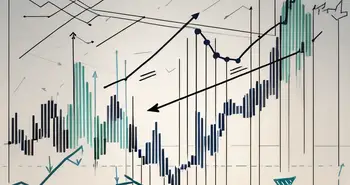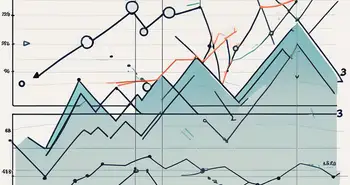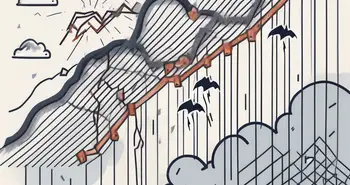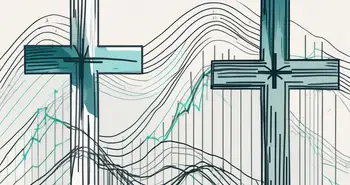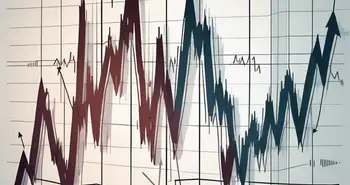The Exhaustion Gap Explained: Spotting Reversals in Market Trends
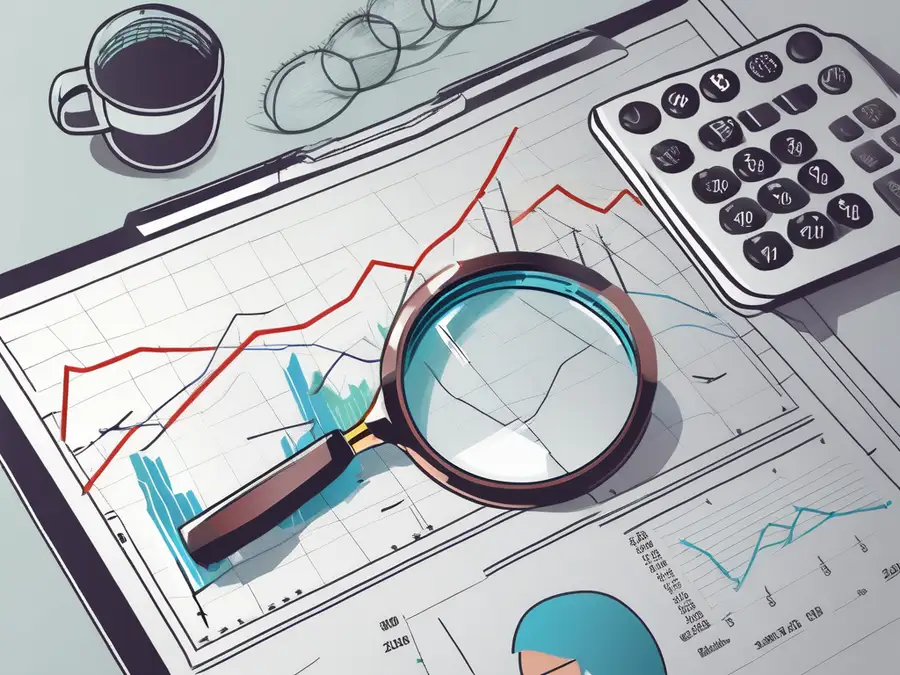
Trading in the financial markets can be a thrilling and potentially lucrative endeavor. However, to be successful, it's essential to understand the various patterns and trends that occur within the market. One such pattern that traders often encounter is the exhaustion gap. In this comprehensive guide, we will delve into the intricacies of the exhaustion gap, its significance in market trends, the psychology behind it, methods for identifying it, strategies for trading it, and the impact of market volatility on this phenomenon.
Defining the Exhaustion Gap in Trading
An exhaustion gap is a price gap that occurs on a trading chart when there is a sudden and significant shift in sentiment among market participants. It typically signifies the end of a trend and can signal an impending reversal. This pattern is called an “exhaustion” gap because it occurs when the market has exhausted its momentum and is unable to sustain the current trend.
Traders often keep a close eye on exhaustion gaps as they provide valuable insights into market sentiment and potential shifts in price direction. By understanding the dynamics behind exhaustion gaps, traders can better anticipate market movements and make informed trading decisions.
The Role of Exhaustion Gaps in Market Trends
Exhaustion gaps play a crucial role in identifying potential trend reversals. When a market is experiencing a strong uptrend or downtrend, traders often look for signs of exhaustion gaps to determine whether the trend is losing steam. These gaps can serve as a warning sign that the prevailing trend may be coming to an end, presenting traders with opportunities to capitalize on potential reversals.
It is essential for traders to exercise caution when interpreting exhaustion gaps, as false signals can sometimes occur. Utilizing additional technical analysis tools and confirming signals from other indicators can help traders validate the significance of an exhaustion gap.
Key Characteristics of Exhaustion Gaps
Exhaustion gaps typically exhibit certain characteristics that make them distinguishable on trading charts. These include:
- A significant price gap compared to previous price movements
- High trading volume during the gap's formation
- A decline in volatility following the gap
Additionally, traders may observe a shift in market dynamics following the formation of an exhaustion gap. This shift can manifest in the form of decreased participation from institutional investors or a change in the overall market sentiment. By monitoring these changes, traders can gain a deeper understanding of the underlying factors driving the market and adjust their trading strategies accordingly.
The Psychology Behind Exhaustion Gaps
To fully understand exhaustion gaps, it's essential to delve into the psychology behind them. Investor sentiment plays a crucial role in driving these gaps.
Exhaustion gaps, a fascinating phenomenon in the world of trading, offer a glimpse into the intricate workings of the human mind within the financial realm. These gaps, characterized by sudden shifts in stock prices, are not merely random occurrences but rather a reflection of the collective psychology of market participants.
Investor Sentiment and Exhaustion Gaps
Exhaustion gaps often occur when sentiment shifts dramatically, causing a sudden change in market dynamics. When market participants become overly optimistic or pessimistic, it can lead to an imbalance between supply and demand, resulting in the formation of an exhaustion gap. These gaps reflect the collective emotions of traders and can provide valuable insights into market sentiment.
Delving deeper into the intricacies of investor sentiment, one can observe how human psychology intertwines with market forces to create these unique patterns. The ebb and flow of emotions, from extreme fear to exuberant greed, serve as the driving forces behind the formation of exhaustion gaps, offering a window into the inner workings of the market psyche.
Fear and Greed: Driving Forces of Exhaustion Gaps
Two primary emotions drive market behavior: fear and greed. When fear dominates, traders become cautious and hesitant, leading to a potential reversal in the trend. Conversely, when greed takes over, traders become overly optimistic and may push prices to unsustainable levels, ultimately leading to a correction. Exhaustion gaps often form as a result of these emotional extremes.
Understanding the interplay between fear and greed is essential in deciphering the complexities of exhaustion gaps. Fear can paralyze the market, causing panic selling and abrupt price drops, while greed can inflate asset bubbles, setting the stage for a sharp correction. By recognizing these emotional triggers, traders can navigate the turbulent waters of the financial markets with a deeper understanding of the psychological underpinnings behind exhaustion gaps.
Identifying Exhaustion Gaps in Trading Charts
Spotting exhaustion gaps amidst the countless data points on trading charts can seem like searching for a needle in a haystack. However, with the right tools and knowledge, it becomes an achievable task.
Exhaustion gaps are significant points in trading charts that indicate a potential reversal in the prevailing trend. These gaps occur when there is a sudden increase in buying or selling pressure, leading to a gap between the previous day's closing price and the current day's opening price. Traders often look for exhaustion gaps as they can provide valuable insights into the market sentiment and potential future price movements.
Tools for Spotting Exhaustion Gaps
Various technical indicators and chart patterns can aid in identifying exhaustion gaps. One popular tool is volume analysis, which can help confirm the significance of a gap. Additionally, paying attention to trendlines, moving averages, and price patterns can provide valuable context when determining whether a gap is an exhaustion gap or merely a temporary fluctuation.
Another useful tool for identifying exhaustion gaps is the Relative Strength Index (RSI), which measures the speed and change of price movements. A divergence between the RSI and the price movement during a gap can signal potential exhaustion. Combining multiple tools and indicators can enhance the accuracy of identifying exhaustion gaps and improve trading decisions.
Common Mistakes in Identifying Exhaustion Gaps
Despite the availability of tools and techniques, traders often fall prey to common mistakes when identifying exhaustion gaps. One such mistake is misinterpreting a regular price gap as an exhaustion gap. It's crucial to consider the accompanying volume and price patterns to confirm whether the gap is an exhaustion gap or a continuation gap.
Additionally, emotional biases and cognitive errors can lead traders to misinterpret exhaustion gaps. Fear of missing out or confirmation bias can cloud judgment and result in erroneous gap analysis. It's essential for traders to approach the identification of exhaustion gaps with a clear and objective mindset, relying on data and proven strategies rather than emotions.
Strategies for Trading Exhaustion Gaps
Trading exhaustion gaps requires a carefully crafted strategy to maximize potential profits while managing risk effectively.
Timing Your Trades with Exhaustion Gaps
Successful trading with exhaustion gaps often boils down to precise timing. Traders may consider waiting for confirmation signals, such as a subsequent price movement in the opposite direction, or combining multiple technical indicators to gauge the strength of a potential reversal. Patience and discipline are vital when determining the optimal entry and exit points.
Risk Management in Exhaustion Gap Trading
As with any trading strategy, risk management should be a top priority when trading exhaustion gaps. Implementing appropriate stop-loss orders and position sizing techniques can help limit losses in case the expected reversal does not materialize. Traders should also consider diversifying their portfolios to mitigate the impact of any unforeseen market movements.
The Impact of Market Volatility on Exhaustion Gaps
Market volatility plays a significant role in the formation and reliability of exhaustion gaps.
How Volatility Influences Exhaustion Gaps
Higher levels of market volatility tend to increase the occurrence of exhaustion gaps. This is because heightened volatility often signifies emotional extremes among traders, resulting in larger price gaps. However, it's important to note that excessive volatility may also indicate reduced reliability of exhaustion gaps, as market participants struggle to determine the prevailing sentiment.
Preparing for Volatility Shifts in Exhaustion Gap Trading
Experienced traders recognize that market volatility is not static and can shift quickly. Therefore, it is crucial to stay updated on economic events and news that may impact market volatility. By staying informed and adjusting strategies accordingly, traders can adapt to these shifts and enhance their chances of success when trading exhaustion gaps.
Personal Advice: Having spent years navigating the intricate world of trading, I have learned that understanding exhaustion gaps is essential for identifying potential trend reversals. One valuable tip I can offer is to combine technical analysis with the ability to interpret market sentiments. This amalgamation allows you to make informed decisions and trade with confidence, increasing the likelihood of profitable outcomes.
FAQ – Understanding the Exhaustion Gap in Trading
What is an exhaustion gap?
An exhaustion gap is a significant price gap on a trading chart that signals the end of a trend and potentially indicates an upcoming reversal.
How can I identify exhaustion gaps on trading charts?
Identifying exhaustion gaps requires careful analysis of volume, price patterns, and the contextual factors surrounding the gap.
What are the key characteristics of exhaustion gaps?
Exhaustion gaps typically exhibit a considerable price gap, high trading volume during their formation, and a subsequent decline in volatility.
How can I trade exhaustion gaps effectively?
To trade exhaustion gaps effectively, it is important to time your trades accurately and implement proper risk management strategies.
What role does market volatility play in exhaustion gaps?
Market volatility influences the occurrence and reliability of exhaustion gaps, with higher levels of volatility often resulting in more prominent gaps.
How can I prepare for volatility shifts in exhaustion gap trading?
Staying informed about economic events and news that may impact market volatility is crucial for preparing and adjusting strategies accordingly.
Ready to take your trading to the next level with the insights gained from understanding exhaustion gaps? Look no further than Morpher, the revolutionary trading platform that leverages blockchain technology to offer zero fees, infinite liquidity, and a unique trading experience. Whether you're interested in stocks, cryptocurrencies, forex, or even niche markets like NFTs, Morpher provides the tools you need for fractional investing, short selling, and up to 10x leverage. Sign up now at Morpher.com and get your free sign-up bonus to start trading with a platform that prioritizes safety, control, and innovation.

Disclaimer: All investments involve risk, and the past performance of a security, industry, sector, market, financial product, trading strategy, or individual’s trading does not guarantee future results or returns. Investors are fully responsible for any investment decisions they make. Such decisions should be based solely on an evaluation of their financial circumstances, investment objectives, risk tolerance, and liquidity needs. This post does not constitute investment advice.

Painless trading for everyone
Hundreds of markets all in one place - Apple, Bitcoin, Gold, Watches, NFTs, Sneakers and so much more.

Painless trading for everyone
Hundreds of markets all in one place - Apple, Bitcoin, Gold, Watches, NFTs, Sneakers and so much more.


